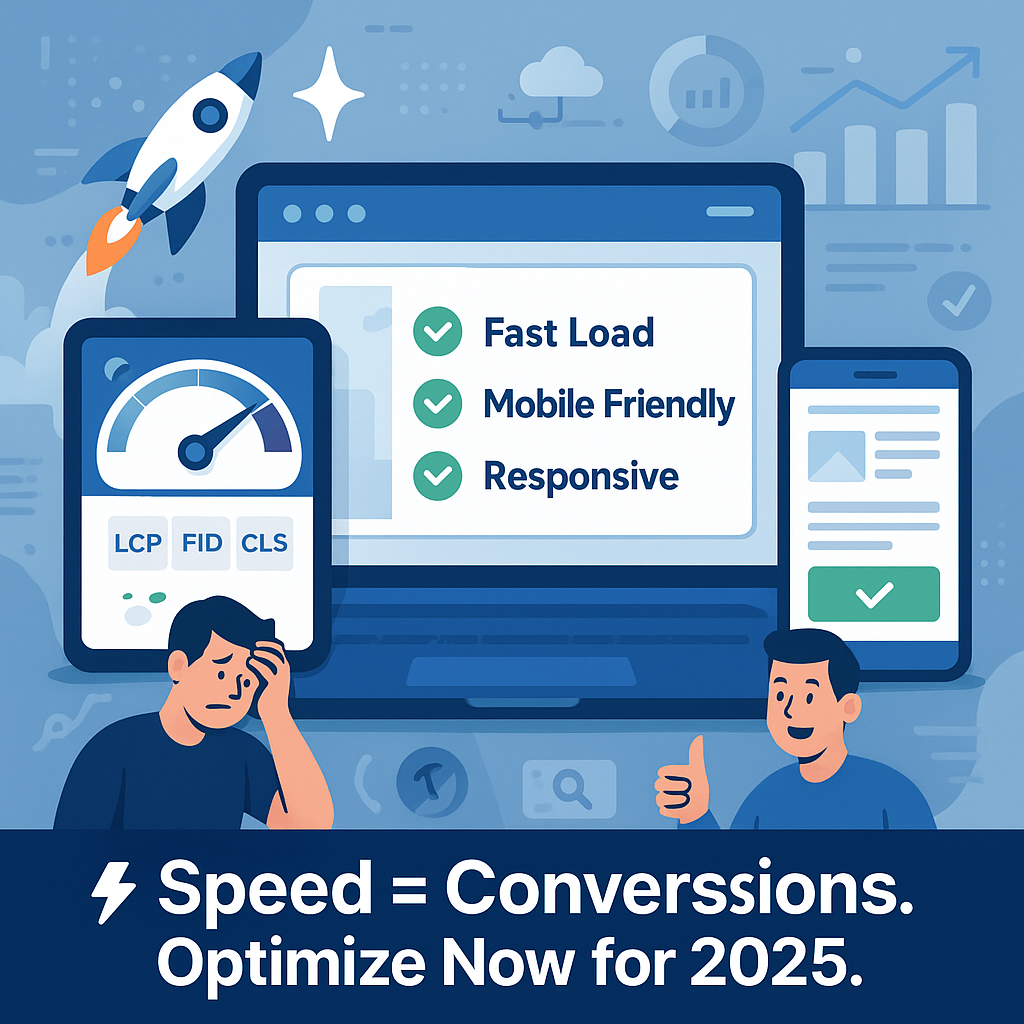In the evolving landscape of digital marketing, website performance is no longer just a “nice-to-have” — it’s a critical factor that determines whether users stay, engage, and convert. And in 2025, website speed and Core Web Vitals are more important than ever.
So why do they matter more now? Let’s dive into what’s changed, what’s coming, and what you can do to stay ahead of the curve.
⚡ First Impressions Start with Speed
Imagine this: a potential customer clicks on your website, but it takes 4–5 seconds to load. Before your beautiful design or your compelling message appears, they’ve already hit the back button.
In 2025, attention spans are even shorter — and expectations are higher.
According to Google, 53% of mobile users abandon a site if it takes longer than 3 seconds to load. But that stat is from years ago — now, even a 2-second delay can drastically reduce your conversion rate.
🧠 What Are Core Web Vitals?
Core Web Vitals are a set of metrics introduced by Google to measure real-world user experience on your site. They’ve been part of the ranking algorithm since 2021 — but in 2025, they’ve become even more prominent thanks to AI-enhanced search, voice browsing, and mobile-first indexing.
Here are the three main Core Web Vitals:
- Largest Contentful Paint (LCP) – Measures loading speed.
→ Ideal: Under 2.5 seconds - First Input Delay (FID) – Measures interactivity.
→ Ideal: Under 100ms - Cumulative Layout Shift (CLS) – Measures visual stability.
→ Ideal: Under 0.1
Google added Interaction to Next Paint (INP) in late 2023, which has taken over FID. So now, we’re tracking how responsive a website feels after it loads.
🔍 Why Core Web Vitals Matter More in 2025
Let’s break down the main reasons:
1. Google’s Algorithm Prioritizes UX Heavily
In 2025, Google’s ranking system places heavy emphasis on user experience signals. Sites that load slowly, shift layouts awkwardly, or have laggy interactions are pushed lower in search rankings — even if they have good content.
SEO isn’t just about keywords anymore — it’s about performance.
2. Mobile Usage Keeps Growing
With 75%+ of traffic now coming from mobile, speed on mobile is essential. Users on the go won’t wait. Google’s mobile-first indexing means your mobile performance is now your primary performance.
3. AI Search Assistants Rely on UX
AI-powered search engines (like Google’s SGE or Bing Chat) now analyze website speed and usability to determine which links to recommend. If your site doesn’t offer smooth UX, it’s less likely to be featured in AI responses.
4. Ad Spend Efficiency Depends on Load Speed
If you’re running paid ads (Meta, Google Ads, etc.), a slow-loading site wastes your budget. Every second delay means higher bounce rates, lower Quality Scores, and less ROI.
5. Users Expect Lightning Speed
We’re in an era of instant gratification. Tools like AMP are fading, but progressive web apps (PWAs), pre-loading, and smart caching are taking over. Users don’t care how your site works — they care how fast it works.
🧰 How to Improve Website Speed & Core Web Vitals in 2025
Here’s a practical list you can follow to level up your site:
✅ Optimize Your Images
- Use WebP or AVIF format
- Compress using TinyPNG, ShortPixel, or Cloudflare Image
- Set responsive image sizes
✅ Enable Lazy Loading
Only load images/videos when they enter the viewport. This reduces load time on the initial page view.
✅ Use a Content Delivery Network (CDN)
A good CDN like Cloudflare, Bunny.net, or AWS CloudFront helps load your website faster regardless of user location.
✅ Minify Code
Remove unnecessary characters from HTML, CSS, and JavaScript files using tools like:
- UglifyJS
- CSSNano
- HTMLMinifier
✅ Use Efficient Hosting
If you’re on shared hosting and your site is lagging — it’s time to switch. Consider:
- Cloudways
- Hostinger Business
- Kinsta or Rocket.net (for WordPress)
✅ Remove Unused Plugins and Scripts
Bloated WordPress plugins, chat widgets, and external scripts (like fonts, embeds, etc.) slow things down. Audit regularly.
✅ Preload Critical Assets
Preload fonts, hero images, or above-the-fold scripts. Use <link rel=”preload”> tags smartly.
✅ Reduce CLS by Reserving Space
Set height/width attributes for images, banners, or embeds. Use CSS to maintain layout structure while loading.
🔍 Tools to Monitor Core Web Vitals in 2025
| Tool | Use |
| Google PageSpeed Insights | Official Google scoring and suggestions |
| Lighthouse (Chrome Dev Tools) | In-depth performance audits |
| GTmetrix | Real-world speed testing with waterfall view |
| WebPageTest.org | Custom location/device testing |
| Search Console → Page Experience Report | Tracks real-world performance data for your site |
💡 Real Examples: Why Speed Matters
Let’s say you run an eCommerce store.
Your site takes 5 seconds to load.
- 🛒 Bounce rate increases by 90%
- 💰 Conversion rate drops by 50%
- 📉 SEO rankings fall behind competitors
- 😟 Users associate your brand with “slow” and “frustrating”
Now, imagine trimming that to under 2 seconds.
- More page views
- Higher engagement
- Lower bounce rate
- Better ad ROI
- Higher revenue
🔮 What’s the Future of Core Web Vitals?
In 2025, we can expect:
- More AI-based site audits (via Search Console or SEO tools)
- Google experimenting with UX-first indexing
- Integration with AR/VR content — which must load even faster
- Voice search compatibility, which favors fast-loading, mobile-friendly pages
🧠 Final Thoughts
Your website is your digital storefront. In a crowded online world, speed and experience determine whether users step in — or walk away.
Fast sites don’t just win in SEO — they win in sales.
In 2025, it’s no longer a question of “should I improve my site speed?” but “how fast can I make it?”
Start now. Audit your site. Optimize. Test. Repeat.
Because when your site runs faster — your business grows faster.

